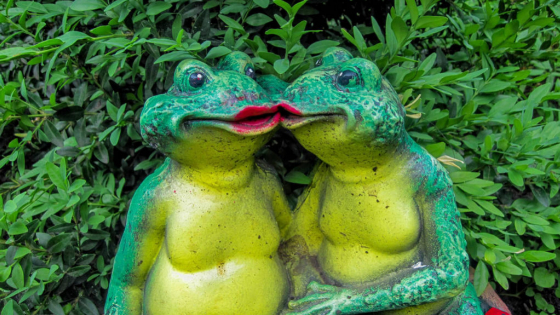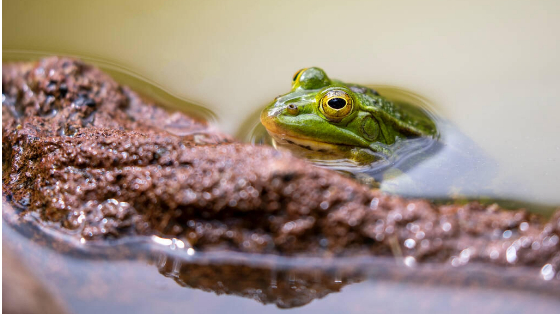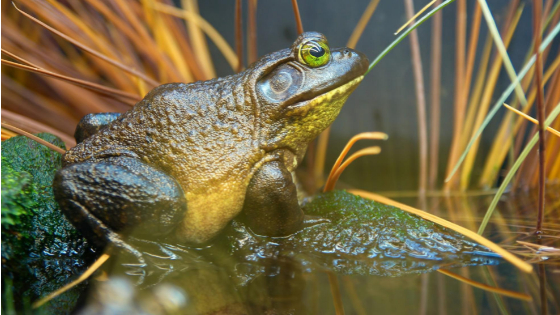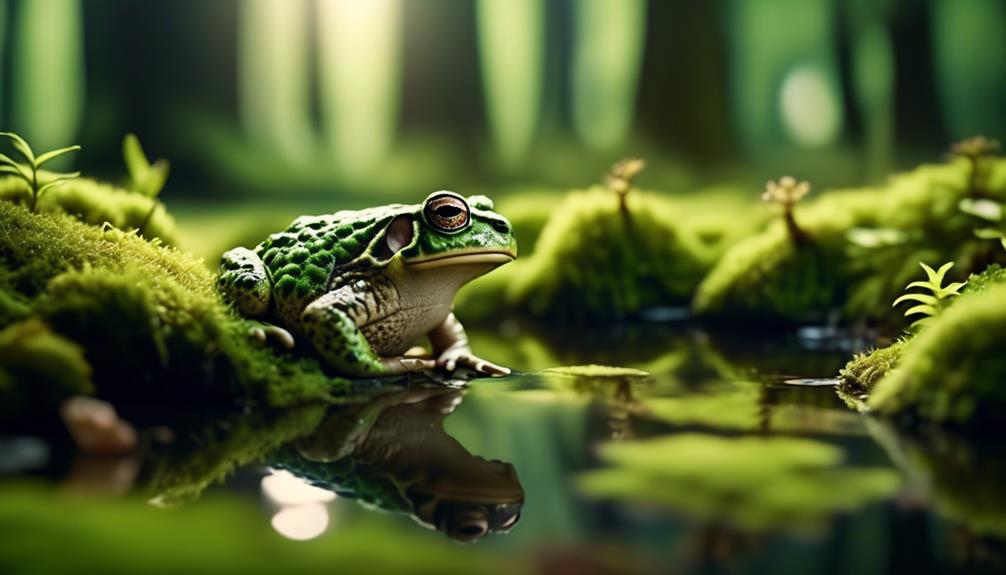
The European green toad, also known as Bufotes viridis, has long captivated the attention of scientists due to its enigmatic nature. This intriguing amphibian, belonging to the Bufotes genus, resides primarily in mainland Europe, with a historical distribution that once spanned across Asia and Africa. With recent genetic and morphological studies revealing the presence of multiple distinct species within its range, the European green toad showcases a surprising level of diversity.
Its appearance, characterized by an array of spots ranging from green to dark brown, with occasional red accents, is just the tip of the iceberg when it comes to understanding this elusive creature. In this article, we embark on an exploration of the taxonomy, distribution, description, and diet of the European green toad, drawing from a wealth of scientific references and studies.
Prepare to be captivated by the secrets that lie beneath the surface, as we delve into the fascinating world of this remarkable amphibian.
Key Takeaways
- The European green toad, scientifically known as Bufotes viridis, is found in mainland Europe, ranging from far eastern France to the Balkans, Western Russia, and the Caucasus.
- The species has a varied coloration on its back, ranging from green to dark brown, with occasional red spots, and the underside is white or lightly colored.
- Females are larger than males and can lay a large number of eggs at a time, ranging from 9,000 to 15,000.
- The European green toad is an opportunistic feeder, consuming a variety of insects and invertebrates, including crickets, mealworms, butterflies, earthworms, beetles, ants, spiders, and caterpillars. It has also been reported to prey on bats.
Taxonomy and Distribution
The taxonomy and distribution of the European green toad, Bufotes viridis, is a subject of scientific study that provides valuable insights into the evolutionary history and geographic range of this fascinating amphibian species. Bufotes viridis belongs to the genus Bufotes, which includes several other species.
It is found in mainland Europe, ranging from far eastern France to the Balkans, Western Russia, and the Caucasus. In the past, its range was broader, extending from the Middle East and Central Asia to western China, Mongolia, and northwestern India, as well as Italy, Mediterranean islands, and North Africa.
Genetic and morphological reviews have identified 14 separate species within this range. Understanding the taxonomy and distribution of the European green toad is crucial for conservation efforts and further exploration of its evolutionary history.
Historical Range and Diversity

Throughout its evolutionary history, the European green toad, Bufotes viridis, has inhabited a vast and diverse range of habitats across Europe, Asia, and Africa. This species historically had a broader distribution, extending from the Middle East and Central Asia to western China, Mongolia, and northwestern India, as well as Italy, Mediterranean islands, and North Africa.
Genetic and morphological reviews have identified 14 separate species within this range, highlighting the remarkable diversity within the Bufotes genus. However, in recent times, the European green toad’s range has become more restricted to mainland Europe, ranging from far eastern France to the Balkans, Western Russia, and the Caucasus.
The historical range and diversity of the European green toad contribute to its importance as a species of interest in evolutionary studies and conservation efforts.
Physical Description and Coloration
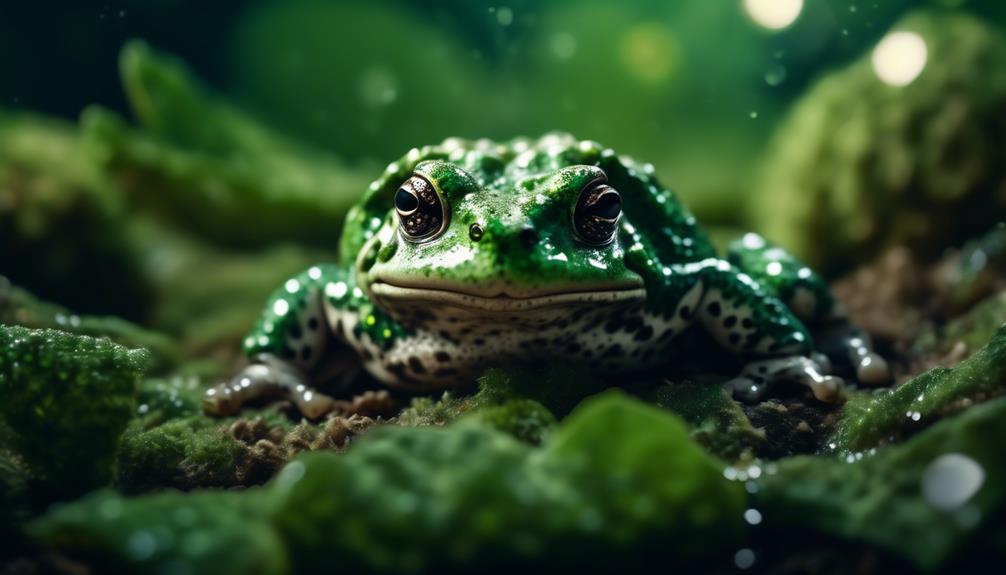
Having explored the historical range and diversity of the European green toad, we now turn our attention to its physical description and coloration.
The European green toad, scientifically known as Bufotes viridis, exhibits varying spots on its back, ranging from green to dark brown, with occasional red spots. The underside of the toad is white or lightly colored.
Females are larger than males and can lay 9,000 to 15,000 eggs at a time. Although the toad can reach a maximum size of 10 centimeters (3.9 inches), this size is rare.
Interestingly, the toad is capable of changing its color in response to changes in heat and light. This unique physical characteristic adds to the allure of this elusive species.
Sexual Dimorphism and Reproduction
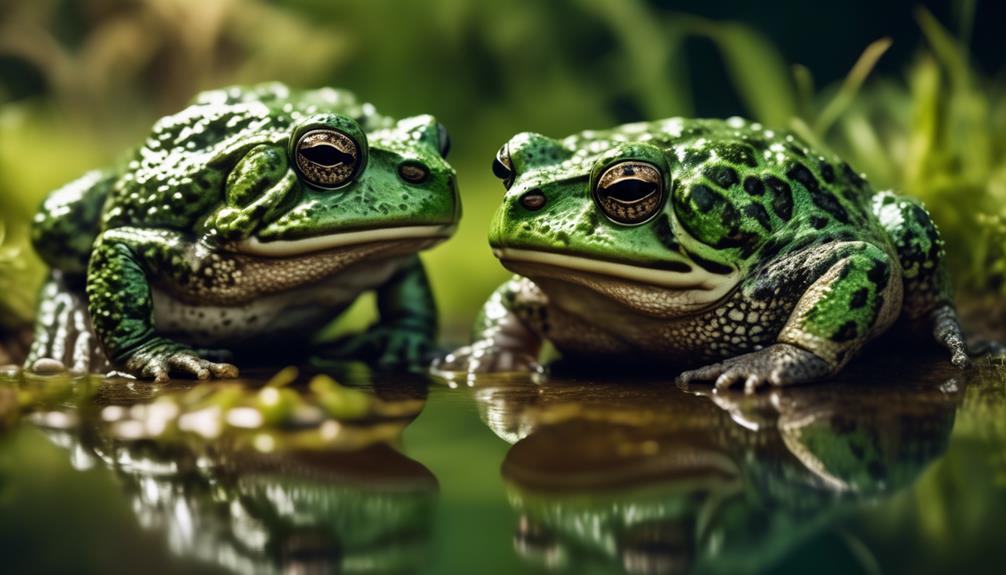
Sexual dimorphism and reproduction in the European green toad reveals distinct differences between males and females, shedding light on their reproductive strategies and behaviors.
Females are larger than males, reaching a maximum size of 10 centimeters (3.9 inches), while males are smaller in comparison.
During the breeding season, which typically occurs from April to June, males produce a high-pitched, bird-like call to attract females. Once the female is attracted, mating takes place in shallow water, where the male grasps the female from behind in a process known as amplexus.
The female can lay a large number of eggs, ranging from 9,000 to 15,000, in long gelatinous strands. These eggs are usually attached to submerged vegetation or other objects in the water.
After hatching, the tadpoles undergo a complete metamorphosis, transforming into adult toads.
This reproductive strategy ensures the continuation of the European green toad population.
Size and Growth of European Green Toad
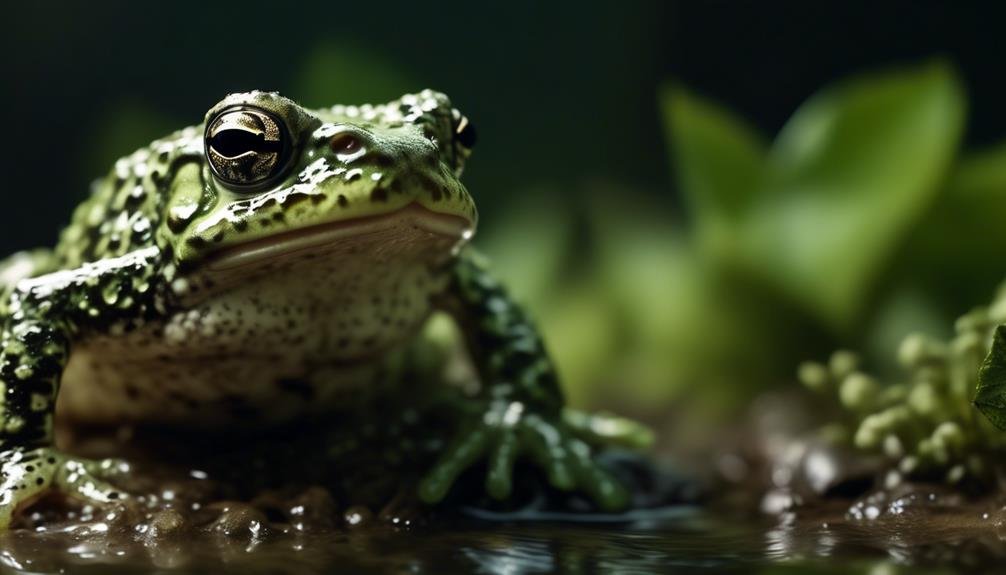
The size and growth of the European green toad, Bufotes viridis, is a fascinating aspect of its biology that offers insights into its development and life history.
This species can reach a maximum size of 10 centimeters (3.9 inches), although such large individuals are rare. Females of the European green toad are generally larger than males.
Additionally, females have the ability to lay a large number of eggs at a time, ranging from 9,000 to 15,000. The growth of these toads is influenced by various factors, including diet, environmental conditions, and availability of resources.
Understanding the size and growth patterns of the European green toad can provide valuable information about its reproductive success, population dynamics, and overall ecology.
Color Changes and Adaptations
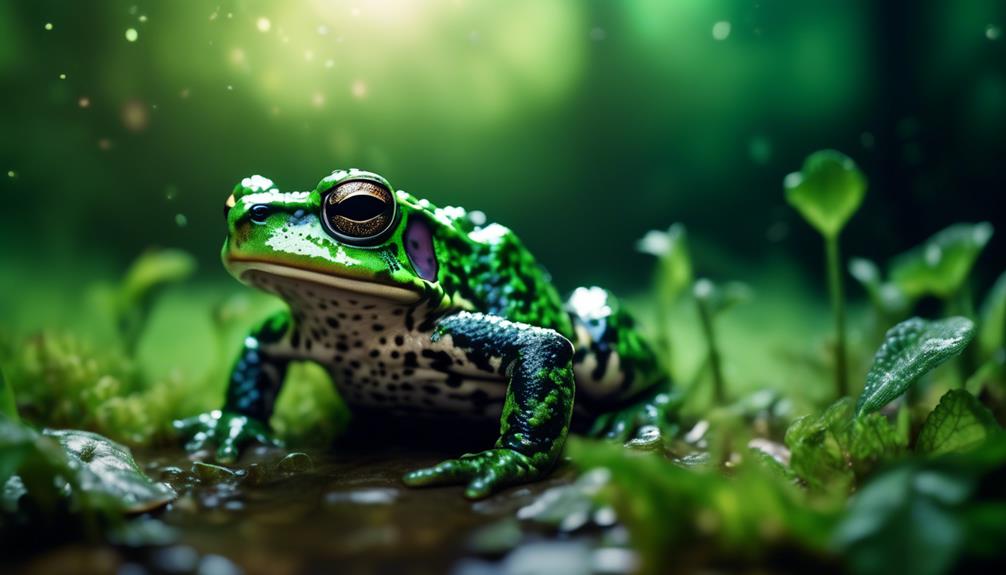
Color changes and adaptations in the European green toad, Bufotes viridis, are remarkable features that enable this species to respond to its surroundings and enhance its survival.
The toad has the ability to change its color in response to heat and light changes. This color change is primarily due to chromatophores in the skin, which contain pigments that can expand or contract, altering the toad’s appearance.
The toad’s ability to change color allows it to blend in with its environment, providing camouflage and protection from predators. Additionally, these adaptations help the toad regulate its body temperature by absorbing or reflecting sunlight.
This flexibility in coloration not only aids in the toad’s survival but also allows for effective communication and mating behaviors.
Diet and Feeding Habits
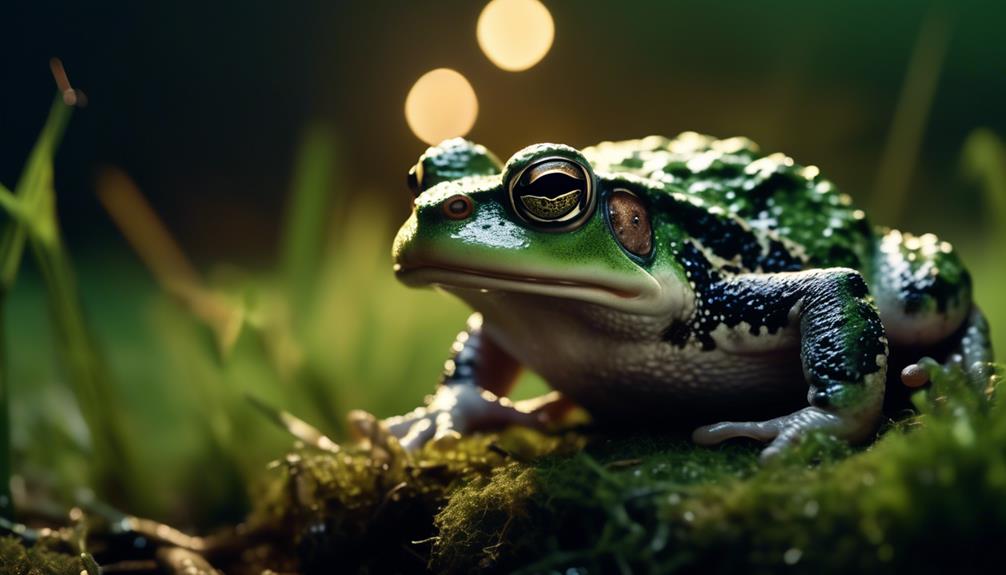
The European green toad, Bufotes viridis, has a diverse diet consisting of various insects and invertebrates. Its feeding habits are fascinating and contribute to its survival in its natural habitat.
- The toad feeds on a variety of insects and invertebrates, including crickets, mealworms, small butterflies, earthworms, moths, beetles, ants, spiders, and caterpillars.
- It is an opportunistic feeder, taking advantage of available food sources.
- The toad primarily consumes terrestrial prey.
- Interestingly, there have been reported instances of the toad attacking bats.
- The European green toad’s diverse diet enables it to obtain the necessary nutrients for growth and reproduction.
Understanding the diet and feeding habits of the European green toad is crucial for conservation efforts and ensuring the species’ continued survival.
Terrestrial Prey and Opportunistic Feeding
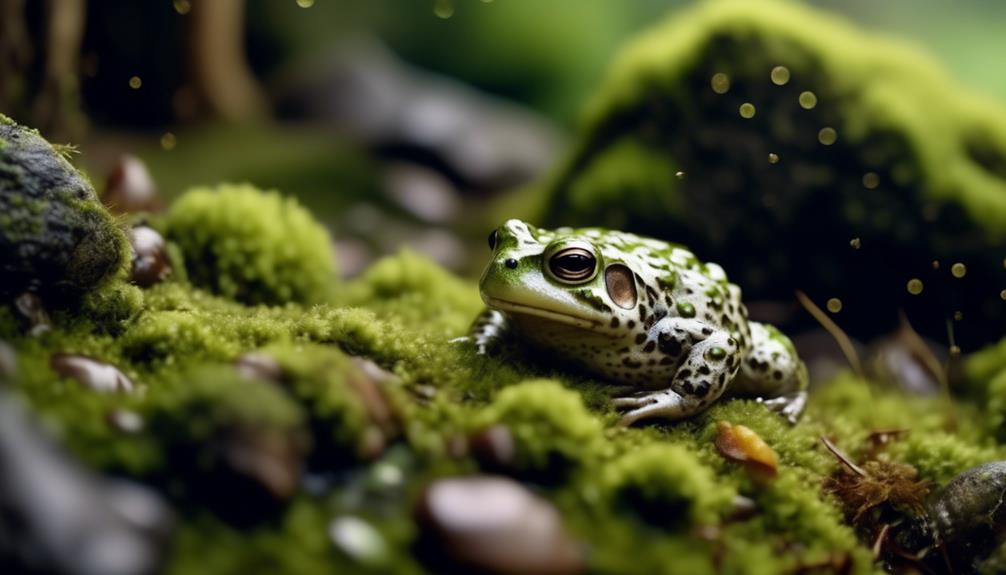
With its diverse diet and opportunistic feeding habits, the European green toad demonstrates a preference for terrestrial prey. This species feeds on a variety of insects and invertebrates, including crickets, mealworms, small butterflies, earthworms, moths, beetles, ants, spiders, and caterpillars. While most of its diet consists of terrestrial prey, there have been reported instances of the toad attacking bats.
The European green toad is an opportunistic feeder, taking advantage of available food sources. Its ability to adapt its diet to different prey items allows it to thrive in various habitats across mainland Europe. By consuming a range of terrestrial prey, the European green toad plays an important role in controlling insect populations and maintaining ecosystem balance.
Rare Instances of Bat Predation
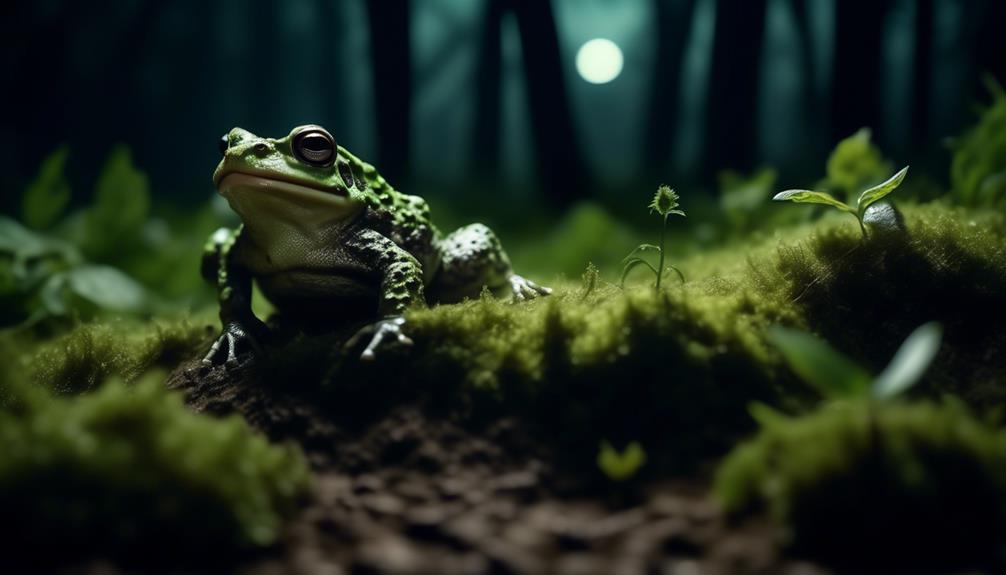
Occasionally, the European green toad demonstrates an unexpected behavior by preying on bats. This rare instance of bat predation adds to the already fascinating repertoire of this elusive amphibian. Here are some intriguing facts about this behavior:
- Opportunistic Feeding: The green toad is primarily a terrestrial feeder, but it takes advantage of available food sources, including bats.
- Stealthy Approach: To catch a bat, the toad uses its camouflage and remains motionless, blending with its surroundings until the perfect moment to strike.
- Quick Reflexes: When a bat comes within striking distance, the toad uses its lightning-fast reflexes to snatch the bat out of the air with its sticky tongue.
- Size Matters: The toad’s ability to prey on bats is influenced by its size. Larger individuals are more likely to successfully capture and consume bats.
- Ecological Significance: These instances of bat predation by the European green toad highlight the complex interactions between different species in ecosystems and the adaptability of these amphibians.
Amphibian Species of the World 6.0

Amidst the diverse range of intriguing behaviors exhibited by the European green toad, a comprehensive understanding of its taxonomy and distribution is provided by the Amphibian Species of the World 6.0.
Scientifically known as Bufotes viridis, the European green toad belongs to the genus Bufotes, which encompasses several other species.
It is predominantly found in mainland Europe, stretching from far eastern France to the Balkans, Western Russia, and the Caucasus. While historically its range was more extensive, genetic and morphological studies have identified 14 separate species within this range.
This online reference, along with the IUCN Red List, provides valuable information on Bufotes viridis, enabling researchers and enthusiasts to delve deeper into the study of this elusive amphibian species.
IUCN Red List and Conservation Status
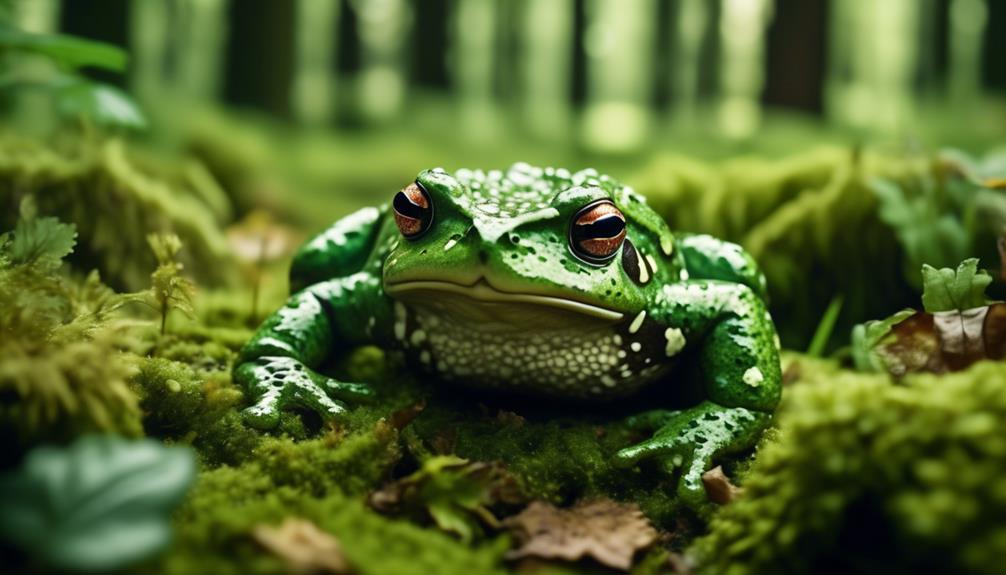
What is the conservation status of the European green toad according to the IUCN Red List?
The European green toad (Bufotes viridis) is currently listed as a species of ‘Least Concern’ on the IUCN Red List. This means that the population of the European green toad is stable and not facing any immediate threats of extinction. However, it is important to note that habitat loss, pollution, and climate change can still pose potential risks to their population in the future.
Conservation efforts such as habitat preservation, restoration, and monitoring are essential to ensure the long-term survival of the European green toad. Additionally, further research on their population, distribution, and specific threats can facilitate targeted conservation strategies for this species.
- The European green toad is listed as a species of ‘Least Concern’ on the IUCN Red List.
- The population of the European green toad is currently stable.
- Habitat loss, pollution, and climate change are potential future threats.
- Conservation efforts should focus on habitat preservation, restoration, and monitoring.
- Further research is needed to understand their population, distribution, and specific threats.
Evolutionary Studies on Bufotes Toads
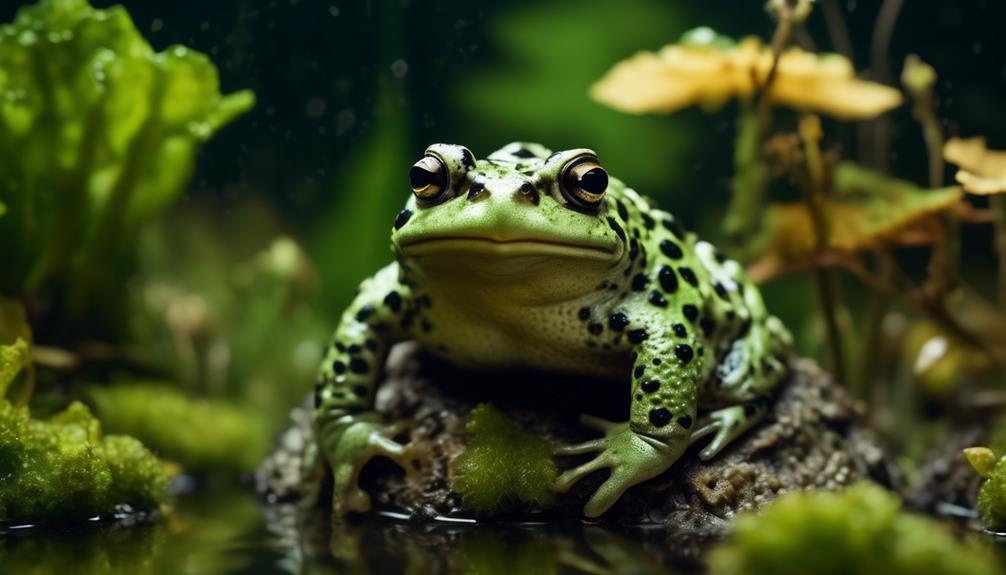
Evolutionary studies on Bufotes toads have provided valuable insights into the genetic and morphological diversity within the genus and its relationship to other amphibian species. These studies have revealed the existence of 14 separate species within the range of Bufotes toads, including the European green toad (Bufotes viridis).
By examining the genetic makeup of these toads, researchers have been able to uncover the evolutionary relationships between different species and populations. Additionally, morphological studies have shed light on the physical characteristics and adaptations of Bufotes toads, such as their color-changing ability in response to environmental cues.
These findings not only enhance our understanding of the evolutionary history of Bufotes toads but also contribute to broader knowledge of amphibian diversity and evolution.
Comprehensive Search for Bufotes Taxon
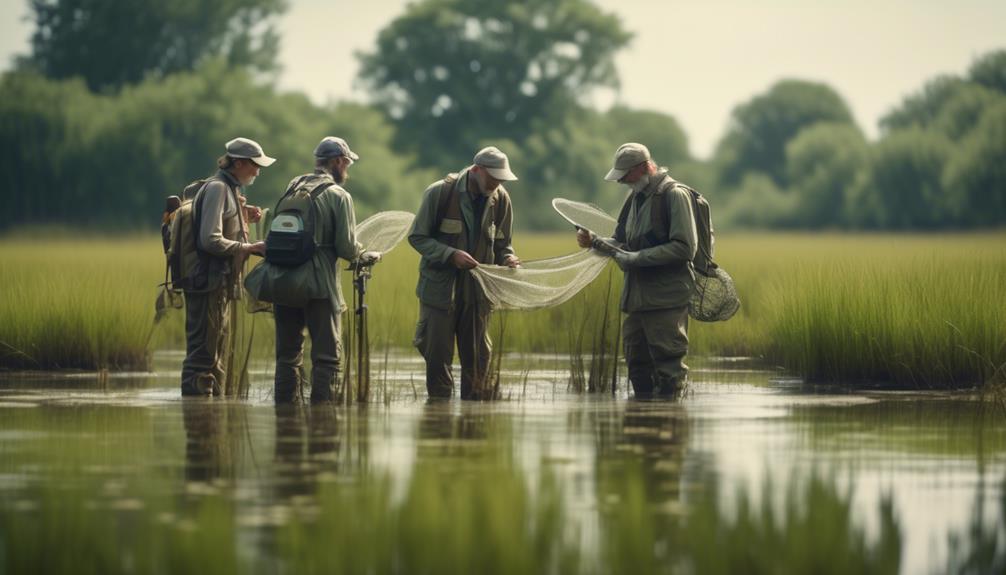
Bufotes toads have garnered significant attention in the field of evolutionary studies, prompting a comprehensive search for the taxon to further expand our understanding of their genetic and morphological diversity. This search has revealed several important findings:
- Genetic analysis has identified multiple distinct species within the Bufotes genus, highlighting the need for further taxonomic research.
- Morphological studies have revealed variations in coloration and size among different populations of Bufotes toads, suggesting potential adaptations to local environments.
- The comprehensive search has expanded the known distribution range of Bufotes toads, uncovering new populations in previously unexplored regions.
- The research has also shed light on the ecological interactions and habitat preferences of Bufotes toads, providing valuable insights into their role in local ecosystems.
- Finally, the search has paved the way for future studies on the conservation status and management strategies for Bufotes toads, aiding in their protection and preservation.
Field Guide to British and European Reptiles and Amphibians
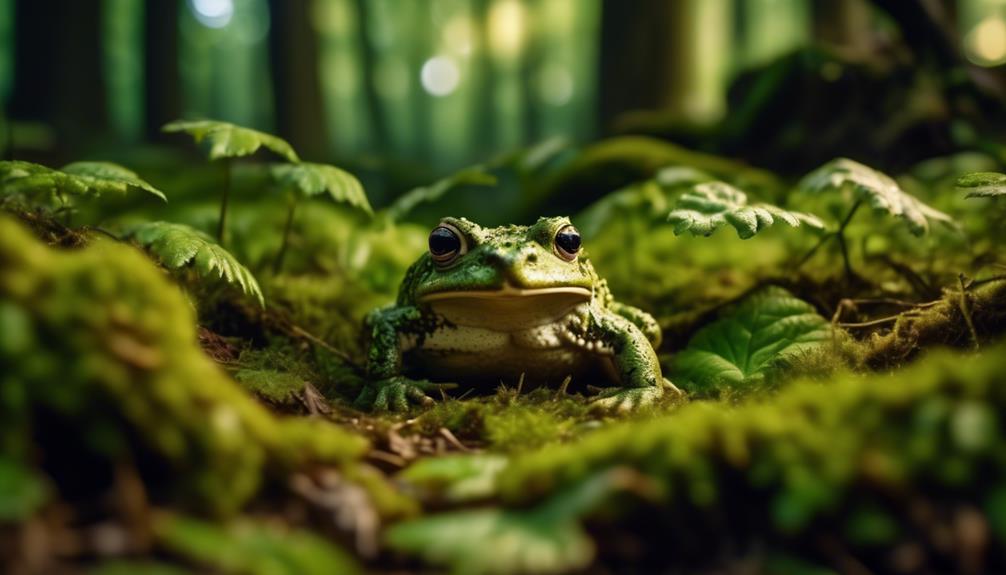
The field of herpetology offers a comprehensive guide to the diverse array of reptiles and amphibians found in Britain and Europe, providing invaluable information for researchers, enthusiasts, and conservationists alike. A field guide serves as a valuable tool for identifying and understanding these fascinating creatures. Here is a table highlighting some of the reptiles and amphibians that can be found in Britain and Europe:
| Species Name | Scientific Name | Distribution |
|---|---|---|
| Common Frog | Rana temporaria | Throughout Britain and Europe |
| European Adder | Vipera berus | Found in most parts of Britain and mainland Europe |
| Sand Lizard | Lacerta agilis | Restricted to heathlands and sand dunes in the UK |
| Slow Worm | Anguis fragilis | Common in Britain and Europe |
| European Green Toad | Bufotes viridis | Mainly found in mainland Europe, ranging from France to Russia, and the Balkans to the Caucasus |
These are just a few examples of the incredible reptiles and amphibians that inhabit the British and European landscapes. Exploring their habitats and behaviors is not only a fascinating endeavor but also crucial for their conservation and protection.
Further Reading on Green Toad Research
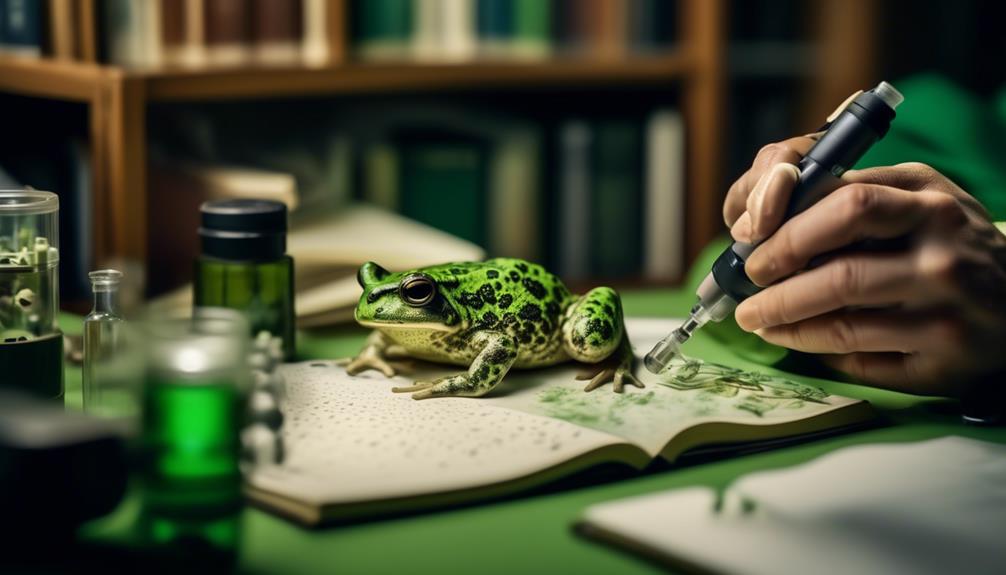
Relevant research publications provide valuable insights into the study of the European green toad, expanding our understanding of this species and its ecological interactions. These publications cover a range of topics, including taxonomy, reproductive barriers, evolutionary relationships, and predator-prey interactions. For further reading on green toad research, consider the following publications:
- Laurenti (1768) published ‘Specimen medicum,’ which describes the reptiles of Austria, including Bufo viridis.
- Colliard et al. (2010) conducted a study on the reproductive barriers in a hybrid zone of West-Mediterranean green toads.
- Stöck et al. (2006) explored the mitochondrial relationships and biogeography of Palearctic green toads.
- Stöck et al. (2008) studied the evolutionary relationships across the Sicilian channel and linked a new green toad from Sicily to African relatives.
- Mikula (2015) published a study on fish and amphibians as bat predators.
These publications provide valuable information for researchers and enthusiasts interested in deepening their knowledge of the European green toad.
Frequently Asked Questions
What Are the Reproductive Barriers in a Hybrid Zone of West-Mediterranean Green Toads?
Reproductive barriers in a hybrid zone of West-Mediterranean green toads refer to mechanisms that prevent or limit interbreeding between different populations within the hybrid zone. These barriers can include differences in mating behaviors, genetic incompatibilities, or ecological factors.
What Are the Mitochondrial Relationships and Biogeography of Palearctic Green Toads?
The mitochondrial relationships and biogeography of Palearctic green toads have been explored in studies by Stöck et al. (2006) and Dufresnes et al. (2019), shedding light on the evolutionary history and geographic distribution of these toads.
How Are the European Green Toad and Its African Relatives Linked Across the Sicilian Channel?
The European green toad and its African relatives are linked across the Sicilian channel through evolutionary relationships, as established by a study conducted by Stöck et al. (2008). Further details can be found in the referenced publication.
What Is the Relationship Between Fish, Amphibians, and Bat Predation?
The relationship between fish, amphibians, and bat predation is a subject of study. Mikula (2015) conducted research on this topic, exploring the role of fish and amphibians as predators of bats.
What Are the Specific Findings and Conclusions of the Studies Mentioned in the Further Reading Section?
The specific findings and conclusions of the studies mentioned in the further reading section include the description of reproductive barriers in a hybrid zone of West-Mediterranean green toads, the exploration of mitochondrial relationships and biogeography of Palearctic green toads, and the identification of a new green toad from Sicily linked to African relatives. Additionally, a study examined the role of fish and amphibians as bat predators.
What Secrets Can the European Green Toad Unveil About Its Elusiveness?
The European Green Toad’s elusiveness may hold the key to its survival. Researchers believe studying its behavior could provide valuable insights into its habitat selection and predator avoidance. By understanding the secrets of the enigmatic mimic poison frog, scientists hope to better protect and conserve this elusive species.
Conclusion
In conclusion, the European green toad, Bufotes viridis, is a fascinating and diverse species found primarily in mainland Europe. With its varying spots and coloration, it showcases remarkable diversity within its range.
As an opportunistic feeder, it consumes a wide array of insects and invertebrates. The European green toad has intrigued scientists for many years, and further research and studies are needed to fully understand its taxonomy, distribution, and behavior.
Overall, this elusive amphibian continues to captivate researchers and nature enthusiasts alike.

